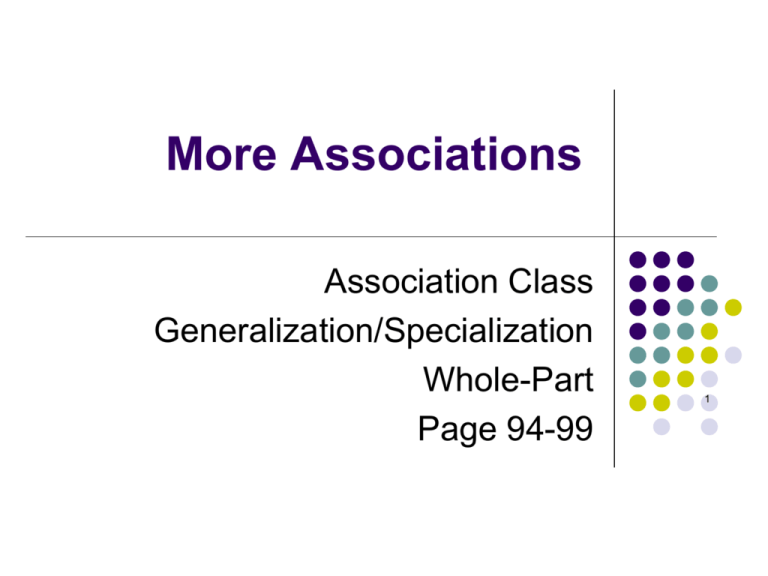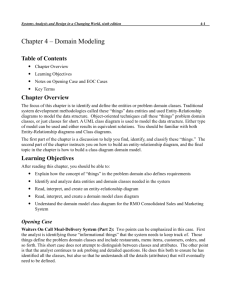Identify O-O Classes
advertisement

More Associations Association Class Generalization/Specialization Whole-Part Page 94-99 1 Revision: Current approaches to system development, primarily object-oriented approaches, use the term class rather than data entity and use concepts and notations based on UML to model the things in the problem domain. A class is a category or classification used to describe a set of objects. So a class is a category, but it is also a set of objects.. 2 Domain Classes Classes that describe things in the problem domain are called domain classes. Domain classes have attributes and associations. Multiplicity (called cardinality in an ERD) applies among classes On a class diagram, rectangles represent classes, and the lines connecting the rectangles show the associations among classes. 3 4 Introduction/Background: Data modeling is WHAT to use for the generic term of items in the real world that a system analyst is trying to discover. We have chosen to simply call them “things.” “problem domain” : Often when we think of problem, we think that something is broken. In O-O this simply means a need that requires a business solution. In other words, system developers are developing a solution for a business need or business problem 5 Two Techniques: The Brainstorming Technique This technique is a joint effort between the analyst and the users. “Things”, Fig 4.1 The Noun Technique Is a more mechanical approach to identifying classes, but it is also a powerful technique. The basic idea is to identify all the nouns, which are always some type of “thing,” and build the list of all these nouns 6 The Brainstorming Technique Identify a user and a set of use cases. Brainstorm with the user to identify things involved when carrying out the use case—that is, things about which information should be captured by the system. Use the types of things (categories) to systematically ask questions about potential things, such as the following: Are there any tangible things you store information about? Are there any locations involved? Are there roles played by people that you need to remember? 7 The Noun Technique: Using the use cases, actors, and other information about the system—including inputs and outputs—identify all nouns. Using other information from existing systems, current procedures, and current reports or forms, add items or categories of information needed. As this list of nouns builds, you will need to refine it. 8 Noun Technique: Ask these questions about each noun to help you decide whether you should include it: Ask questions, such as is it important and inside the scope, to see if it should be included. Ask questions to see if it really should be excluded, such as is it only a report or an input or is it an attribute. Ask questions to see if it needs further research. In other words that you cannot answer whether it needs to be included or excluded. 9 Associations: An association is a naturally occurring relationship between specific things, such as an order is placed by a customer and an employee works in a department. Is placed by and works in are two associations that naturally occur between specific things. Information systems need to store information about employees and about departments, but equally important is storing information about the specific associations. 10 More “Associations” Association class(??) Generalization/specialization Whole-part relationships aggregation and composition 11 Association Class Example: Courses may be offered as many CourseSections A student may enrolls in many Course-Sections A Course-Section may be taken by many students A course is described by Course Section Course ID, Description, Credit hours Section no, times, venue Student: 12 Association Class cont. There is a M:N association between Course Section and Student Problem: Sometimes M:N associations involve additional data that are important and must be stored Where must the Grade that each student receives for the course-section be stored? Solution: Association Class 13 Generalization/Specialization The idea that people classify “things” ito similarities and differences There are several types of motor vehicles: Cars, trucks, and tractors All motor vehicles share certain general characteristics Specialization groups different type of things Special types of cars include sports-, sedan- and sport utility cars 14 15 Generalization/Specialization This association is used to structure or rank things from more general to the more special The more general class is a superclass The more specialized class below it is the subclass It is learning by refining the classification Set/Subset 16 Inheritance Allows subclasses to share characteristics of their superclass It is a key concept that is possible because of Generalization/Specialization 17 Example A Sale is described by A sales date, tax and the total amount A sale is defined by certain types of sales An online sale, described by the on site time and the chat that was use An in-store sale, described by the store ID, register ID and the clerk ID Telephone sale, described by the clerk ID and the length of the call 18 Abstract class It exists so that subclasses can inherit from it There is no actual object called Sale Each sale must be one of the three subclasses Concrete class: Have actual objects All depends on the intention of the analyst 19 Whole-Part Associations Aggregation whole-part relationship between the aggregate (whole) and its components (parts), where the parts can exist separately and is represented by an open diamond Composition whole-part relationships that are even stronger, where the parts, once associated, can no longer exist separately, and is represented by a solid dark diamond 20 21 Model the following: A customer has many accounts, ito wholepart association The human body consists of A head Two arms Two legs A torso 22





